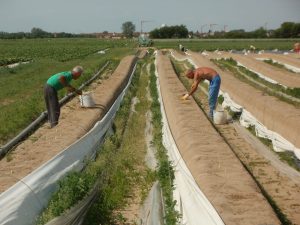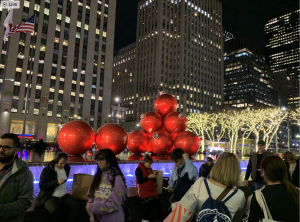Chapter 5. Cultural Patterns and Processes
5.3 Folk vs. Popular Culture
5.3.1 Overview of Folk / Local and Popular Culture
While music may be considered a cultural universal, there is a unique difference between folk and popular cultural forms of music. Folk culture (sometimes also referred to as local culture) is distinguished by cultural elements which are practiced by small, homogeneous groups that see themselves as a community apart from others. These unique cultural groups are often physically isolated in rural areas, or they are socially isolated by an active rejection of popular culture.
In contrast, popular culture is found in large, heterogeneous societies that share certain cultural elements such as media. Check below for a listing for a closer understanding of the difference of folk/local culture and popular culture.
Folk/Local Culture |
Popular Culture |
|
|
|
|
|
|
|
|
| Table 5.3.1 Differences Between Folk/Local Culture and Popular Culture |
5.3.2 Folk Culture and Local Culture
The term folktends to evoke images of what we perceive to be traditional costumes, dances, and music. It seems that anything with the prefix folkrefers to something that somehow belongs in the past and that is relegated to festivals and museums. The word folk can be traced back to Old Norse/English/Germanic and was used to refer to an army, a clan, or a group of people. Using this historical information, folk culture (folktales, folklore, etc.) can be understood as something that is shared first among a group of people and then with the more general population. It is a form of identification. Folk is ultimately tied to an original landscape/geographic location as well. As expressed in above table, folk cultures are found in small, homogeneous groups. Because of this, folk culture is stable through time but highly variable across space.
Folk culture is transmitted or diffused in person. Knowledge is transmitted either by speaking to others or through participating in an activity until it has been mastered. Cooking food is taught by helping others until an individual is ready to start cooking. Building a house is learned through participating in the construction of houses. In all cases, folk cultures must learn to use the locally available resources. Over time folk cultures learn functional ways to meet daily needs as well as satisfy desires for meaning and entertainment. Folk cultures produce distinctive ways to address problems.

Source: “Tai O” by Doggie82~commonswiki assumed (based on copyright claims) via Wikimedia Commons is licensed under CC BY-SA 3.0.
Houses tend to be similar within a culture area, since once a functional house type is developed, there is little incentive to experiment with something that may not work.
Clothing is made from local wool, flax, hides, or other materials immediately available. Local plants serve as the basis of folk medicinal systems. People are entertained by music that reinforces folk beliefs and mythologies, as well as reflects daily life. Folktales/folklore exist as foundational myths, origin stories, or cautionary tales.

Source: Photo by Barbara Crain, CC BY 4.0
Holidays provide another form of entertainment. Special days break the monotony of daily life. A holiday such as Mardi Gras, which has its roots in the Catholic calendar, provides an occasion to flout cultural norms and relieve tension. Another way of providing escape from monotony is provided by intoxicants. Although often not considered when discussing culture, human beings have been altering their mental states for millennia. The production of alcohol, cannabis, tobacco, or coca demonstrates that folk cultures understood the properties of psychoactive substances. Later these substances would be commercialized into modern products. Folk culture can also be expressed as craftsmanship versus factory work. Hand production of goods requires a great amount of knowledge to select materials, fabricate components, assemble, and finish a product. Contrast this with industrial production in which workers need to know very little about the final product and have little relationship with it.

Source: Photo by Barbara Crain, CC BY 4.0.
As folk cultures have receded there has been a return to valuing the folk. The Slow Food movement and the growth of cultural tourism have largely been driven by the desire to experience elements of folk culture. As early as the German Grimm Brothers (19th Century Germany) people have wanted to preserve and promote folk culture. John Lomax (1867–1948) traveled the United States trying to record as many folk songs and folk tales (including slave narratives) as they faded from human memory.

Source: Photo by Barbara Crain, CC BY 4.0.
A local culture refers to a community of people in a specific location who identify collectively, share common experiences and characteristics, and strive to preserve unique customs that distinguish them from others. The culinary engagement of some Germans in specific regions with their beloved white asparagus (Spargel) that ne
eds to be eaten fresh in May is definitely a local culture (see Figure 5.2.4). Depending on the region it is served with select meats (smoked ham-raw or cooked; pork chops) and potatoes. As you can see, vegetarian options exist too.

Source: “20120511Spargelernte5” by AnRo0002 via Wikimedia Commons is licensed under CC0 1.0 Universal.
Both local and popular cultures coexist within the same spaces, manifesting in distinct ways and continually evolving. In the age of globalization, popular culture spreads rapidly worldwide, finding acceptance or resistance among different populations. Despite this, local cultures endure, thriving in many places but facing ongoing challenges from pervasive popular culture. Local communities decide whether to embrace, reject, or modify aspects of global cultural diffusion based on factors such as religion, community traditions, family structures, or limited exposure to outside influences.
5.3.3 The Changing Cultural Landscape
It is understood that folk culture has been declining in the face of popular culture for some time. What is driving this decline? There are many things, with different underlying processes.
- Politically, in the last few centuries, many places have been incorporated into states (= countries). These states have often pursued nationalistic policies that made life difficult for minorities of nearly every variety. The growth of a state-sanctioned national culture is the beginning of popular culture (also called “pop” culture). The introduction of public schooling or an official language can serve as a vehicle for promoting national values like the pledge of allegiance in the United States. Even if there is some overlap between the old culture and the new, the old has been pried loose from its central position in communal life.
- Economics also plays a role. Small, rural communities have been shrinking globally for centuries, since the beginning of the Industrial Revolution. Leaving the spatial confines of a folk culture makes reproducing that culture very difficult due to its close connection to place. When people migrate to places practicing popular cultures, the pressure to acculturate and assimilate is tremendous.
- Infrastructure changes have also aided the diffusion of popular culture. Roads bring in outside people, as well as reduce the friction of leaving a place. The internet has dramatically reduced the friction of distance regarding the diffusion of popular culture. It took decades for tomatoes to diffuse from the Americas to Italy, but we know about a new iPhone months before it even gets released.
The United States is a huge laboratory of cultural interchange. Innumerable distinctive folk cultures were already in the Americas when the Europeans arrived. Waves of people from folk cultures arrived for decades, and they changed the larger culture of the United States.
Places of folk culture aren’t the only places that are changing. Many places with an established popular culture are subject to interaction between different pop culture spheres. At one time immigrants to the United States came from folk cultures. Now they are often from areas of popular culture. The Spanish-speaking world has its popular music stars, and chart-topping musicians from different countries will often collaborate, garnering airplay and sales around the world. World regional cuisines are subject to being fashionable as well.
5.3.4 Popular Culture

Source: Photo by Barbara Crain, CC BY 4.0.
Popular culture is culture that is bought. Think about your daily life. You work to buy food and clothing, pay your rent, and entertain yourself. The origin of each ingredient in your food could be hundreds or even thousands of miles in either direction. Your clothing almost certainly wasn’t made locally, or even in this country. Your house might look just like any house in any subdivision in North America, placeless and with little connection to local resources.
Popular culture is driven by marketing. Entire industries exist to convince us that our desires and needs will be best met through shopping. Why is this? Because without sales, the companies that produce pop culture will go bankrupt.
- Popular culture industries must continuously reinvent themselves. Being popular today is not a guarantee of longevity. To convince consumers that last year’s t-shirt is now unacceptable, it is necessary to promote fashion. Fashion is not just a concept related to clothing. It is the reason that automobile companies make cosmetic changes to their products every year. It is why fast food restaurants continually change some parts of their menus. Without the cachet of fashion, consumers may feel socially disadvantaged. This explains why some people with very limited incomes will spend money on expensive luxuries.
- In terms of popular culture, holidays are simply reasons to sell merchandise. The commercialization of Christmas has been increasing for over a century in Western countries. Now it is possible to see Christmas displays in Japan or China, places with few Christians but many available consumers. The same sort of marketing can be seen in the expansion of Halloween globally and the growth of Cinco de Mayo in the United States.
- Hierarchical diffusion plays prominently in popular culture diffusion. Larger places tend to generate many of pop culture’s hit songs, clothing styles, and food trends. Diffusion in popular culture is highly related to technology. Although it wasn’t invented as such, the internet has become a venue for advertisement. Clickbait headlines and ad revenue have created an atmosphere where every conversation is a sales pitch.
- This hierarchical diffusion means that innovations tend to diffuse from large, well-connected places to other large, well-connected places first, then trickle-down to smaller and smaller places. The gap in time that it takes for a new idea or product is known as cultural lag. In some places, there is almost no cultural lag. In very remote places, some innovations take a very long time to arrive. Bear in mind that there are places in the United States that still have no internet service.
Popular culture covers large populations with access to similar goods and services, but the pressing need to sell drives almost incessant modification, generally at a superficial level. Because of this we usually describe popular culture as stable across space but highly variable across time.
5.5.5 Local/Folk Culture – Commodification Examples
Heritage Pathways – White Asparagus (Spargel) Germany
The fashion industry is renowned for its rapid pace of change, constantly evolving to reflect shifting trends, consumer preferences, and cultural influences. Designers, brands, and retailers continuously introduce new collections and styles to capture the zeitgeist of each season, driving demand for the latest looks. Social media and digital platforms have accelerated this process, enabling instant sharing of runway shows, celebrity endorsements, and influencer-driven trends across the globe. As a result, what is considered fashionable can swiftly transition from one trend to the next, influencing consumer behavior and shaping the industry’s dynamics with remarkable speed and agility.
Jeans have stood out as one of the enduring fashion trends, remaining highly sought-after items that have evolved in size, appearance, and color while maintaining their timeless appeal.
Fashion Industry – Jeans
Jeans were primarily used as durable workwear. The origins of jeans trace back to the 19th century in the United States, where they were initially designed as sturdy trousers using the durable fabric denim. During the California Gold Rush in the mid-1800s, Levi Strauss and Jacob Davis collaborated and enhanced jeans’ durability with copper rivets at stress points. These early jeans were practical garments worn by workers in various industries, including miners, ranchers, and railroad workers.
It was in the mid-20th century, after World War II, that jeans began to transition from workwear to mainstream fashion. They gained popularity among young people as symbols of rebellion and casual style, especially with the rise of iconic brands like Levi’s and Wrangler. From there, jeans evolved into a global fashion staple, worn for both work and leisure, with countless variations in styles and designs to suit different tastes and trends.

Source: Photo by Barbara Crain, CC BY 4.0
Jeans have become a global fashion staple, valued for their style and versatility. Even though local folk clothes in Pakistan, for example, are made of more lightweight and breathable fabric which helps endure the hot climate, jeans manage to transcend climate.
Housing Industry

Source: Photo by Barbara Crain, CC BY 4.0
The transition from folk culture houses to modern housing reflects significant changes in architectural styles, materials, and living standards over time. Initially, folk culture houses were often built using locally available materials and traditional construction methods that varied widely based on regional climates, cultural practices, and available resources. These houses were typically simple in design, reflecting the practical needs and cultural values of the communities they served.

Source: Photo by Barbara Crain, CC BY 4.0
With urbanization, industrialization, and advancements in construction technology, modern housing emerged characterized by the use of industrial materials such as concrete and steel, and incorporation of modern amenities like plumbing, electricity, and heating systems. Most people do not build the houses they live in; instead, they are usually mass-produced by construction companies using standardized designs.
The commodification of folk intoxicants mentioned earlier has had a decided effect on the modern world. Low-alcohol beers have a minimal effect on the human body compared to commercially distilled spirits. The opium poppy, dangerous enough in its raw form, can be processed into heroin. The same can be said of coca (now used to produce cocaine) or tobacco. In folk form, these substances tended to be used for ritual purposes. In the context of popular culture, they are used in great quantities. Nevertheless, old folk patterns are still visible in the popular culture landscape. Italians still drink wine, a product they have produced for centuries, only now it might be bought from somewhere else. The Russian climate was good for producing grain and potatoes, which eventually were distilled into vodka.
Selling culture goes well beyond just food and clothing. Popular music and other forms of entertainment (video games, movies, etc.) are huge commercial entities marketing products well outside their places of origin. Movies made in the United States are often being made with the understanding that their international box office sales will be larger than their domestic sales. This is also true of other mass media products. These products are often related to other popular culture products. Companies rely on the familiarity consumers will have with a movie character to sell clothing, toys, video games, conventions, and more movies in that series.


